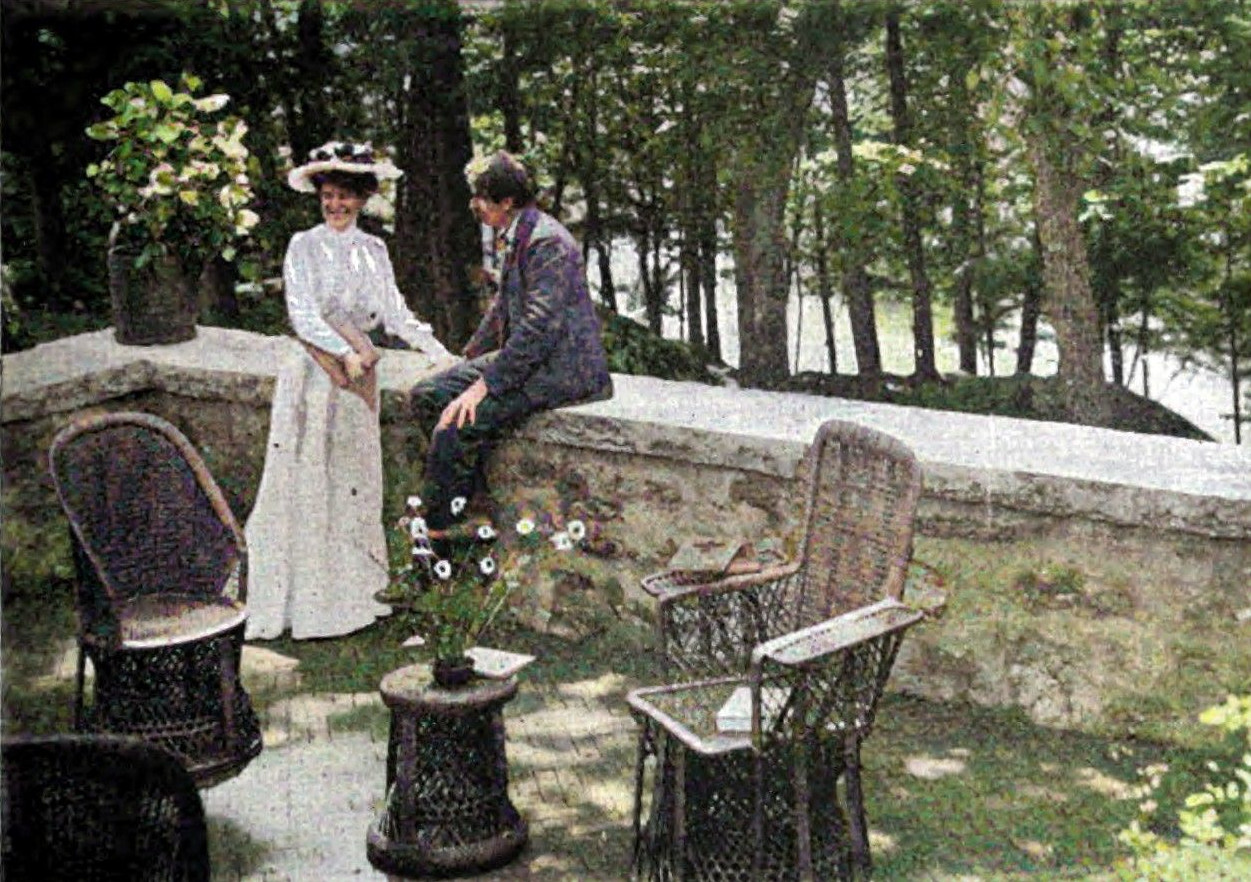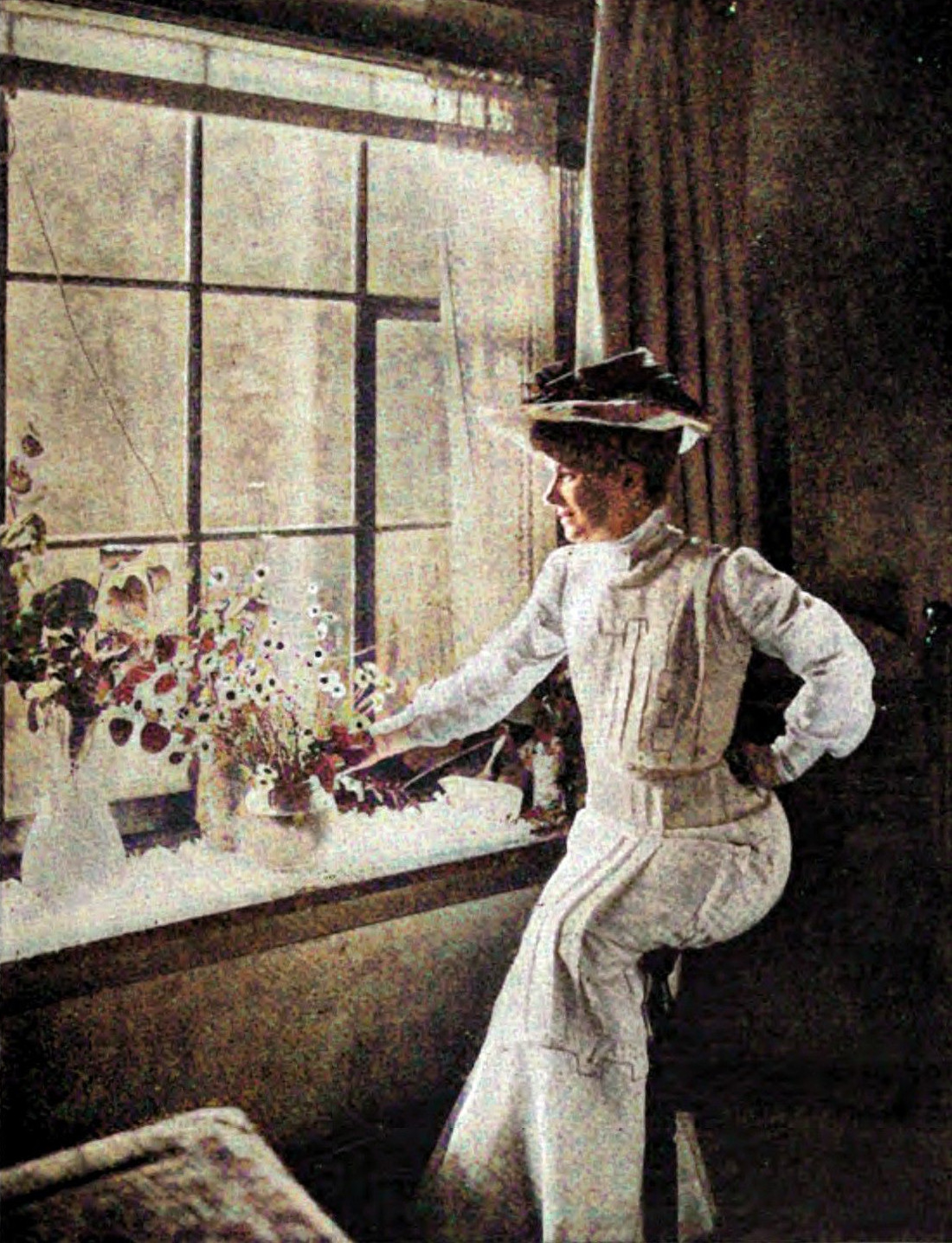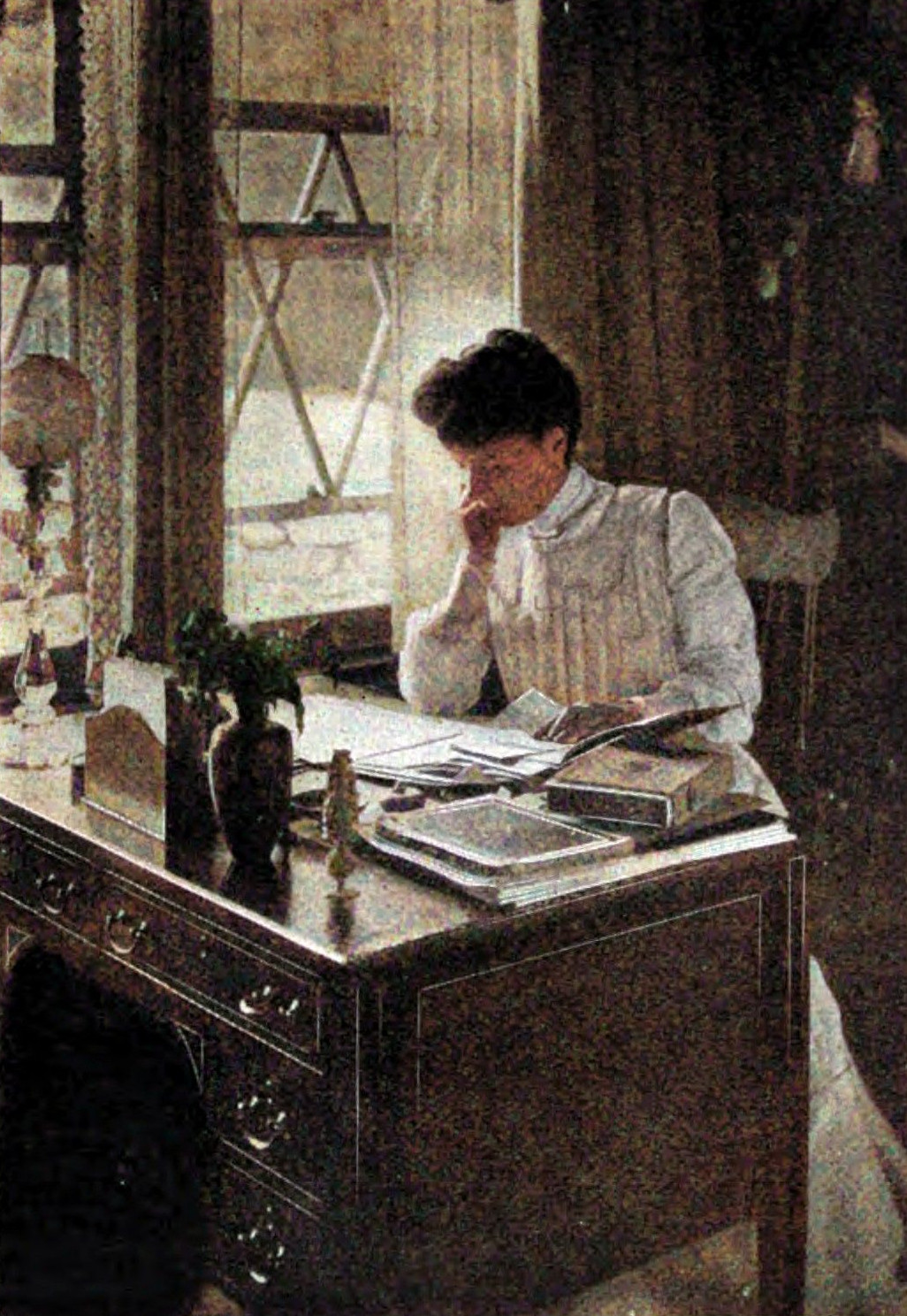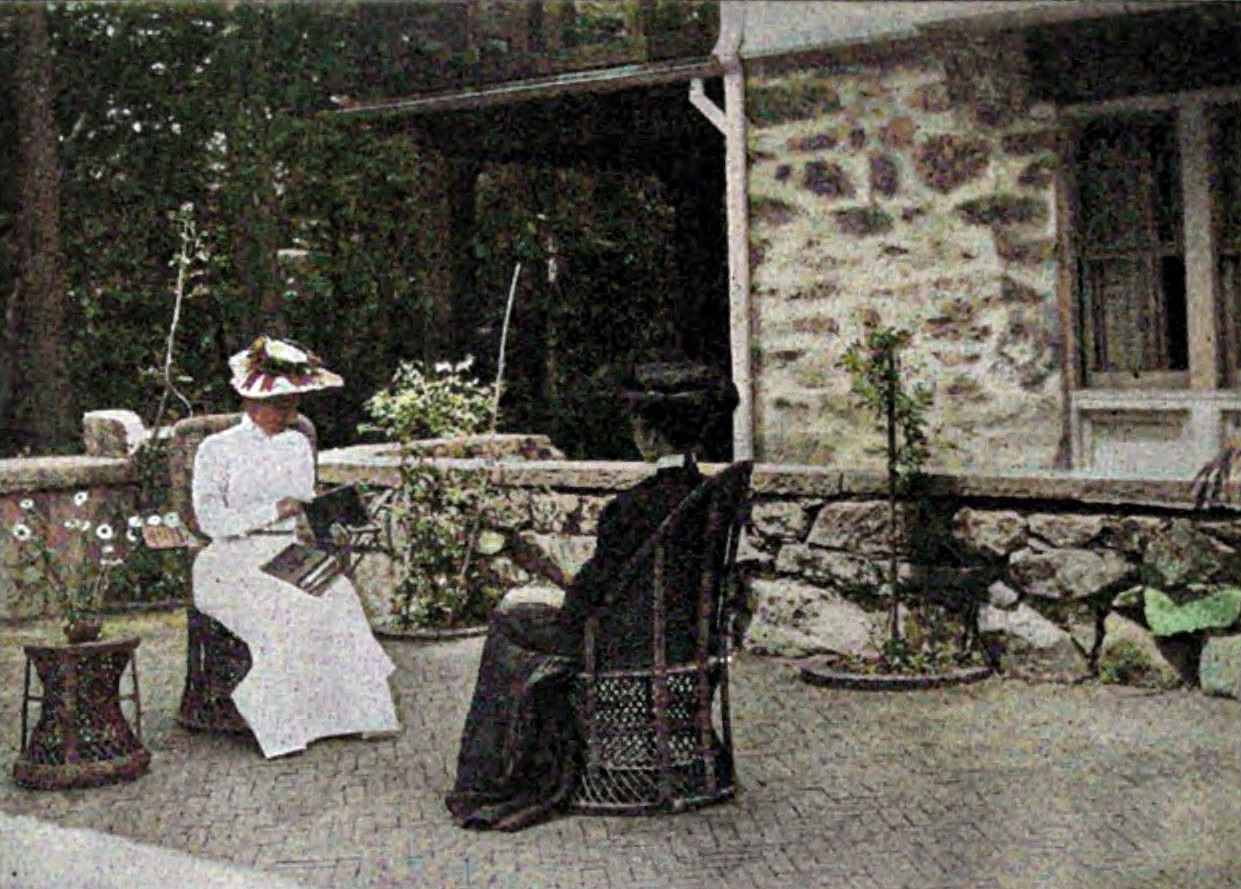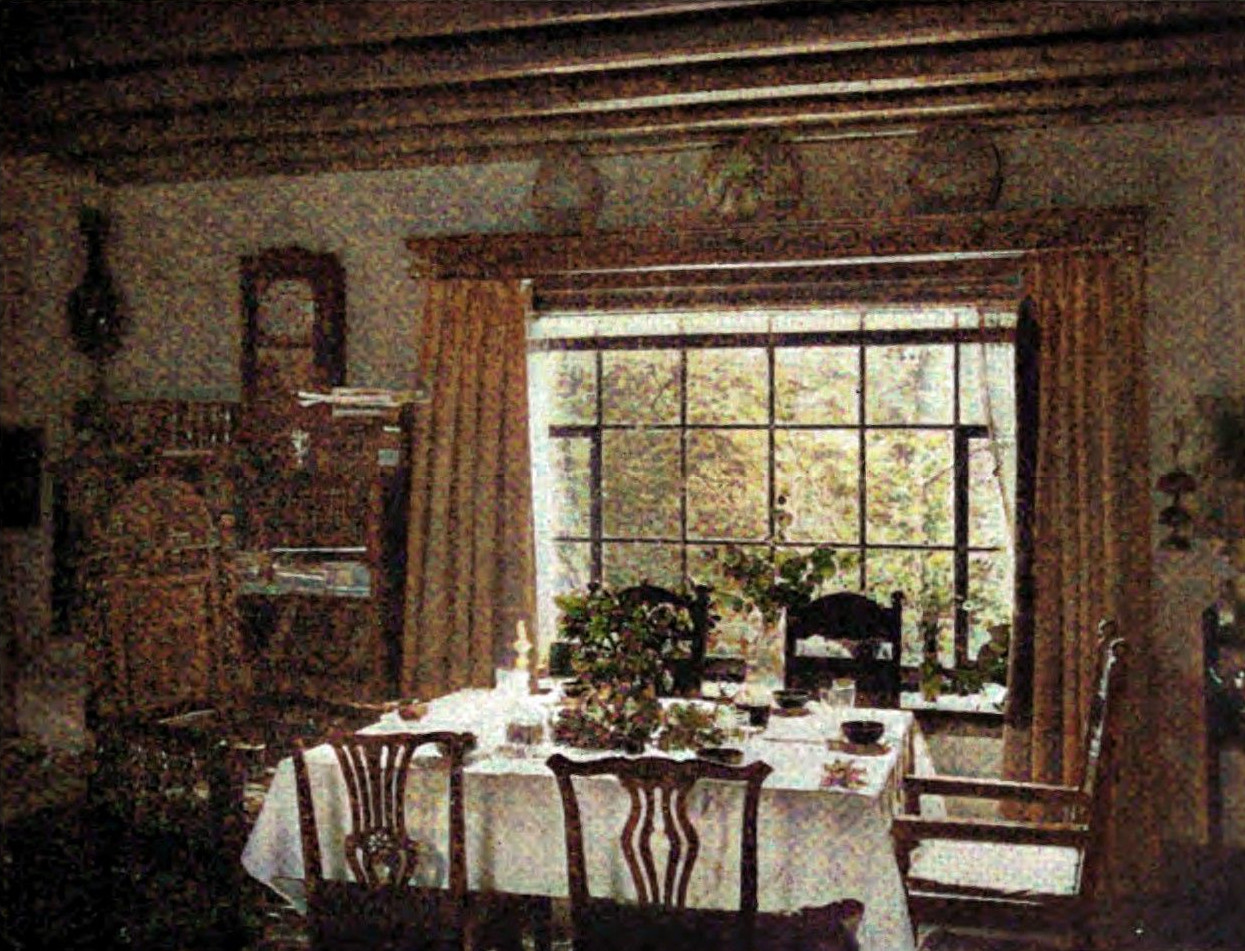A Twentieth Century Hostess
ⓒ 1903
Mrs Grace Gallatin Seton, writer, artist, “bookmaker,” club woman, home-maker, an expert in woodcraft, excels as a hostess; she is a delight to her friends, a woman not only of cultivated mind but of winning ways and gracious manners.
Grace Gallatin was born in California. After her early girlhood her home was on the Atlantic coast, her school days being spent in the east, with intervals of foreign travel. In 1894 she was sending weekly letters from Paris to American papers.
In 1896 she was married to Ernest Thompson Seton — naturalist, author and illustrator — and since that time she has been his constant companion and helper. She is one of the most effective woman speakers in New York city, but she is not often heard from the platform these days, since Mr Seton has given so large a part of his time to lecturing. Mrs Seton has much magnetism, is the picture of health, with physical as well as mental energy. One who sees her as hostess in her own drawing room, noting her graceful figure and clear eye, can well imagine her a picturesque figure on horseback, and, as we have always heard of her — a good shot.
“If the illustrations in our books are good,” said Mr Seton to the present writer, as he worked at his easel, “thanks are due her, for she does the designing. Mrs Seton is primarily an artist, although she neither draws nor paints. I am not an artist, while I both draw and paint, as you know. Mrs Seton has made a new departure in assuming that bookmaking is a fine art. To her a book is a creation, all belonging to one scheme.”
“Why, yes,” put in Mrs Seton, who entered at this juncture, “to make a book, one must know its story to properly design any part of it. I, of course, attend to every detail of our books; select cover color, make cover design, see to title page, to copyright; I choose style and quality of paper, kind of type, and also decide upon marginals. These leaves which you now see Mr Seton drawing are for a marginal of our new book, Two Little Savages, which will come out in October.”
Mrs Seton took a blank leaf of the “dummy,” which shows the form and size of the future book. “Now this is how I help with the illustrating; these pencil marks are all mine; this circular mark is to be a chipmunk, these wavy marks mean a little hill or mound, and this long line running up and down is to be a tall tree. Mr Seton does the drawings.”
Mrs Seton not only can write a book, and design its exterior, but make every particle of the book itself, and its pictorial possibilities are her delight. She insists that “the pencil may be handmaiden to the pen, and the thought of the text amplified and beautified by the medium of illustrations; the book a harmonious whole because the relations of the two are properly recognized and maintained.”
Mrs Seton is becoming celebrated for her entertaining, and whether it be a reception, dinner, musical or house party which she gives, it is sure to be a success, and unique in its way. Each season’s plan of entertaining has new and novel features.
At their country place, Wyndygoul, named for one of the Seton estates in Scotland, Mr and Mrs Seton now stay from May until December. This place is a Connecticut forest, which until their arrival had been a wilderness, a “forest primeval,” though only one hour by railroad from New York. The station nearest is Cos Cob, which was so named for Chief Cos Cob, grandfather to “Ab,” the last of the Indian tribe of Pequots who lived in this section. Ab had his dwelling in a rock on the land now owned by the Setons. Here he lived, died and is buried. From the station to the Seton gate is about a half mile; there remains a quarter of a mile more before the house is reached. The first purchase was but a few acres upon which the house was built. But the Englishman’s love for owning the land that adjoined his has prevailed until there have been added one hundred and fifty acres to the original purchase.
The house is situated on a mound and built of rough-hewn stone that was quarried on the place. The exterior is antique in appearance, with a pleasing oddity which tells of modern production. Its style of architecture has been spoken of as Italian; I asked about it and learned what I might have guessed, that it was “Setonian,” pure and simple. The construction and arrangement inside as well as out are peculiarly _effective, with a simplicity that is very pleasing. The living room is large and is the workshop, the studio of the Seton family. The outlook is in three directions. In one end of the room is a window that fills almost the entire wall space, and through it one looks out upon a deep ravine with its fine old trees, moss-grown rocks, creeping vines, wild flowers and ferns. The house shows exquisite harmony in its furnishings and decorations, which are gathered from many lands. On the walls are etchings and tapestries; here and there are bronze figures, choice pieces of carved ivory, odd pieces of silver, delicate china. Indian relies abound, Indian rugs are on the floors.
At Wyndygoul Mrs Seton can indulge her fancy in the matter of floral decorations; she uses for the table almost exclusively the wild flowers, vines and ferns that grow in such profusion about, beginning in earliest spring with blue and white violets, dogwood, wild azalea and columbine — there is never a lack. A decoration of which she is very fond for the center of the table is a glass bowl filled with blue iris and surrounded with maidenhair fern. Another is a center bowl of mountain laurel surrounded with ferns and some trailing vines of the cinquefoil radiating to the edge of the table. The wild pink and moccasin flower are among her valued possessions; the field daisies and the blackeyed Susans she gives a place; the bluebell and goldenrod, the foxglove and cardinal flowers. She uses also the Bouncing Bets, the white and purple asters, Robert’s plantain and blue vervain, the latter being effective in keeping witches away. Among the vines we find the green briar, the clematis, the American ivy and the bittersweet.
Wyndygoul is well adapted to house parties, which are a part of the season’s program there. Mrs Seton has shown especial skill in this kind of entertainment. At the time of the housewarming she furnished the house complete, supplied its larder, manned it with servants, and entertained a dozen people for a week in midwinter. This tremendous task was to all appearances easily accomplished. Here was truly a twentieth century frolic; among the guests were scholars, critics, sculptors, authors, editors and artists; here wit and wisdom met and mingled. Mrs Seton personally makes no small part of the charm of her home, while Mr Seton is a genial host, a good raconteur and a good listener. Their Wednesday evenings at home in their studio in New York city have been highly popular in literary and art circles.
Dinner giving is Mrs Seton’s favorits form of entertaining. Her dinners are celebrated, not only for the menu, which is prepared with taste, but for the bright people gathered at her board. Once each year Mrs Seton gives a dinner for her own sex, from which even the lord of the manor is barred. These dinners are entirely out of the beaten track. It may be a colonial or it may be a western dinner; but whatever it may be, the invitation, the menu and the service are in keeping.
The “great horn spoon” dinner, given recently, will serve to illustrate. The invitations were in red.
Decorations for the table were black and red; the name cards were red paper spoons. The table was of Flemish oak, with black centerpiece covered with Jacq roses and crimson streamers radiating to various sides. In the very center of the table was a mirror sunk in a wreath of roses, the mirror simulating water, in which floated two crystal swans. The decorations were asparagus ropes and red roses from the chandelier to the centerpiece, over which a big red rose was suspended, on which was inscribed a legend to the effect that the whole feast was sub-rosa. A bid for the great horn spoon — a story — was told at each course by a different guest.
The great horn spoon was in evidence. On it had been carved the face of the “Ancient Mistress Sapphira”; it was inscribed and dedicated “To the Modern Sapphira.” At the end of the long handle was a tiny hole, and about it carved in delicate letters, “Sup sorrow with this end.” In the bowl of the spoon was the inscription, “Be merry with this.” Mr Seton, not privileged to carve any part of the food for that dinner, carved the spoon.
| Menu of The Great Horn Spoon dinner | ||
| Vermouth cocktail | ||
| Hors d’oeuvre | ||
| Olives | Caviar on toast | Salted almonds |
| Grape fruit with sloe gin | ||
| Danish soup | ||
| Deviled crabs | ||
| Rocky mountain elk served in polished hoofs of animal | ||
| Sweet pickles | Currant jelly | |
| Roast sucking pig stuffed with whole apples and nuts | ||
| Creamed spinach | Roast potatoes | |
| Seton sorbet | ||
| Asparagus | Teal duck | Crabapple jelly |
| Alligator pears, sauce vinaigre | ||
| Ices in form of spoons | ||
| Ginger | Marron glace | |
| Fruit tartlets | ||
| Coffee | Chocolate | Bonbons |
Mrs Seton is a member of the New York Woman’s Press club, a member and state delegate of the League of American Pen Women, president of the Pen and Brush club, author of that charming book, A Woman Tenderfoot, a writer of verse, some of which has been set to music. Yet busy as she is, she finds time to write much and well for leading periodicals on subjects of interest to women.
- Good Housekeeping vol. 37. No. 3., Říjen 1903, s. 305, link na stránku➚, zdroj➚
- Good Housekeeping vol. 37. No. 3., Říjen 1903, s. 306, link na stránku➚, zdroj➚
- Good Housekeeping vol. 37. No. 3., Říjen 1903, s. 307, link na stránku➚, zdroj➚
- Good Housekeeping vol. 37. No. 3., Říjen 1903, s. 308, link na stránku➚, zdroj➚
- Good Housekeeping vol. 37. No. 3., Říjen 1903, s. 309, link na stránku➚, zdroj➚
- Good Housekeeping vol. 37. No. 3., Říjen 1903, s. 305, link na stránku➚, zdroj➚
